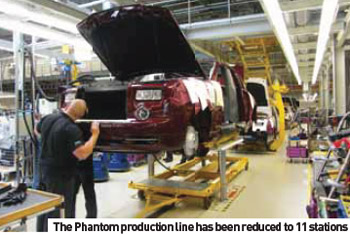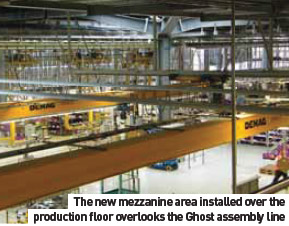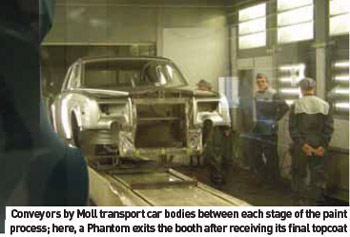
When BMW took full control of Rolls-Royce Motor Cars in 1998, it was quick to launch the first new model, the Phantom, just five years later. Since then, Rolls-Royce has expanded the Phantom range to include the standard car – if a Rolls-Royce can ever be called ‘standard’ – the Phantom Extended Wheelbase, the Phantom Coupé and the Phantom Drophead Coupé.
Now, Rolls-Royce is about to introduce its second model range, the 'baby' Ghost. Like all the Phantom versions, the Ghost will have its chassis and body-in-white (BIW) fabricated at BMW’s Plant Dingolfing, Germany, utilizing some of BMW’s own equipment to prepare the car’s underlying structure. This, says Xaver Franz, Director of Manufacturing at Rolls- Royce, is for a combination of reasons.
 “On Phantom, the whole aluminium structure, with the weldings, glue process and clinch process is future-proofing the vehicle. Another reason is that as we only produce a small number of cars per year, we can avoid having to purchase extremely expensive robotics and other machines.”
“On Phantom, the whole aluminium structure, with the weldings, glue process and clinch process is future-proofing the vehicle. Another reason is that as we only produce a small number of cars per year, we can avoid having to purchase extremely expensive robotics and other machines.”
The all-aluminium spaceframe for Phantom is handwelded, which while avoiding unnecessary capital investment also offers built-in flexibility within the product range. According to Franz, in creating the chassis for the extended-wheelbase version of the Phantom, much of the car’s lower portion is changed and it’s easier to achieve this with manual welding. As could be expected, the associates welding the chassis undergo intensive training.
“We have specially-developed fixtures to keep the BIW pieces in position. The aluminium is joined using seam welding, which is completed by specially-trained welders. Once qualified as a welder, our associates attend a special welding school where, after you graduate, you are allowed to weld special carrier parts and other parts which are on the chassis.
“The Phantom is the only car in the BMW Group that is predominantly aluminium,” says Franz. “Certain BMW cars, such as the 5- and 6-Series, have some aluminium parts, but the rest is steel. In some cases, doors are also aluminium, but not a complete car. Nevertheless, the BMW plant Dingolfing is a centre for aluminium competence and therefore, there is plenty of knowledge we can draw from in certain areas.”
Rolls-Royce makes good use of the other facilities available at Plant Dingolfing, utilizing such elements of the infrastructure as the power supply, maintenance and even the cafeteria. But most importantly, BMW shares its chassis dipping facilities with the specialist carmaker.
“We corrosion-proof the chassis and body of each vehicle at Dingolfing, starting after the late (BMW) shift stops at 10pm and running through to about 5am,” says Franz. “For technical reasons, we cannot add our car bodies to the BMW workflow. Due to the aluminium content, the dip has different process parameters, e.g. temperature, than for the BMW models.”
A completely new set of cycle times had to be written for processing the Rolls-Royce chassis. “Our bodies are longer and heavier, so take more time to heat up, cool down and to dry. It’s a problem with aluminium bodies, they must be cooled down in a slow, gradual way. If they’re cooled too quickly, you get tension between the inner and outer surface, or if you’re too slow it simply takes too long.”
As many of the presses at Dingolfing are for stamping steel body parts, Rolls-Royce is only able to complete a portion of its body part production using the available facilities.
 To meet production requirements, the company employs dedicated Rolls-Royce stamping facilities at the same plant, while also contracting out some part production to the BMW Group’s Eisenach facility.
To meet production requirements, the company employs dedicated Rolls-Royce stamping facilities at the same plant, while also contracting out some part production to the BMW Group’s Eisenach facility.
“Eisenach is ostensibly a tool manufacturing facility, but there is some stamping equipment on site, so we decided to make use of the additional capacity,” says Franz. “We also have small supplier press shops that do work for us, maybe more efficiently than we can do internally, owing to the small production runs.
“We use the experience of the BMW tooling engineers, gained from development of the doors on the M3 and the engine bay lining of the 5-Series, which are both aluminium.
But unlike BMW, Rolls-Royce uses a lot of aluminium profiles that are welded together. In fact, Audi came to visit us to see our operation.” According to Franz, who before joining Rolls-Royce in 2007 spent 25 years with BMW, it is standard procedure for OEM companies to benchmark processes and then compare them with their competitors.
Another item pressed in Germany is the optional brushed stainless steel bonnet (hood) offered on versions of the Phantom. Further incorporating the material around the grille and the windscreen surround, this replaces the standard painted bonnet. The brushed finish is achieved by using robots in Dingolfing before the corrosion proofed chassis and BIW are shipped to the company’s Goodwood, UK headquarters for painting and final assembly.
Late July 2009 saw the new, smaller Rolls-Royce, Ghost, in its second phase of pre-production, referred to internally as VS2. Launch production will follow, with series production anticipated to start before the end of 2009. Introduced as the 200EX at this year’s Geneva Motor Show, the car had what was perhaps its final viewing under that nomenclature at this year’s Salon Prive in London before having its official unveiling as Ghost at the upcoming Frankfurt Motor Show.
 Since leaving the company’s spiritual home in Crewe to take up residence at the brand new Goodwood facility in 2003, Rolls-Royce had only been producing the Phantom range. With all versions assembled on the same line, space was not at a premium, but with the launch of Ghost, a second dedicated production area was needed. This required a major overhaul of the workflow layout.
Since leaving the company’s spiritual home in Crewe to take up residence at the brand new Goodwood facility in 2003, Rolls-Royce had only been producing the Phantom range. With all versions assembled on the same line, space was not at a premium, but with the launch of Ghost, a second dedicated production area was needed. This required a major overhaul of the workflow layout.
Over 18 months (starting in late 2007), Rolls-Royce has completed a £40 million expansion of the assembly hall by creating a raised mezzanine area, using holidays and periods of slower production to carry out the work. “We completed the work in early 2009. It took around 1,500 tonnes of concrete and almost 1,000 tonnes of steel to create the new raised area,” says Franz. “The mezzanine has opened up approximately 5,600m2, without enlarging the plant’s footprint.”
The arrangement of the two lines takes into account the anticipated production figures for each model. As Ghost numbers are likely to far exceed those of the Phantom, the original 20-station line on which the Phantom was assembled has now been given over to the new model, for two key reasons. First, the start of the line is adjacent to where the painted car bodies enter the production hall and secondly, the additional stations will facilitate ease of assembly.
Meanwhile, Phantom production has been moved to a new line running east-west and comprising only 11 stations. Takt times on the Phantom line have been adjusted to suit the reduced line length, but what really dictates production times is customer demand and the need to maintain overall quality. “The Phantom line currently has takt times of 125 minutes,” says Franz. “If we wanted to produce seven or eight cars per day, then we would reduce that to an hour, by adding more associates to each station. Of course, we try to balance production, so we make a time estimation, a time study, and put it in rough packages, including the potential work of every associate.
“Rather than time, it is necessary to maintain the quality.
If we needed a takt time of three hours, then that is what we would work to. Also, with the four Phantom versions, we need our associates to understand the particular requirements of each model. For example, installing the headliner for the Drophead Coupé is completely different to that of a normal Phantom.”
As the new Ghost line reaches its final stages, it makes a right-hand turn to run parallel with the Phantom assembly line. “We put the two together to give both lines access to the same filling stations and test facilities; it would be prohibitively expensive to run two setups for the small number of cars we produce,” says Steve Horscroft, Assembly Planner in charge of Quality, Process and Planning. “Engines and transmissions come fully-filled, but all cars have 25 litres of fuel added, as well as other liquids.”
Within the full production total, more than 80% of all Rolls-Royce cars include bespoke features requested by the customer. This can create further complications for general assembly activities. Explains Xaver Franz: “First, there’s the standard (assembly) work that the associates learn. Then there are small changes, but more or less, it’s the same work with minor differences. If it’s a bigger option, or a bigger change, then we support the associates with methodic engineers. We added offices for these engineers in the refitting of the plant floor. Every morning, we discuss the options to be fitted that day and the work is attended by a methodic engineer, who in turn has a strong connection to a development engineer. Depending on the complexity of the work, the engineers work together.”
While most requested features have been done at least once before, some customer requests can require changes from the ground up. Then, the process starts before assembly begins, with bespoke designers drawing up plans in Dassault Systemes’ Catia software package. “We can make changes to the cars at any point in the build process, from BIW through to general assembly. Methodic designers will then come in, perhaps on a lunch break, to carry out heavy bespoke work; a fridge in the boot, for example.” According to Franz, if the work requires additional time, it can be completed after the production process in the rework area.
The paintshop at the Goodwood facility has to fulfil its own share of customer requests. “Although we have more than 40,000 stock colours to choose from, we are wellknown for being able to paint a car any desired colour,” says Peter Guest, General Manager of the Surface Finish Centre.
Changes in the plant layout have also affected the paintshop, particularly in the case of how the car bodies arriving from Germany are dealt with. “The new plant layout incorporates a buffer area to allow for balancing between paintshop and assembly hall shifts,” explains Guest.
Car bodies arriving from Germany are delivered with the corrosion proofing process complete and are ready to enter the paintshop, which features booths by Bergkamp and Durr robotics. “The first step is to apply a primer, matched to the final topcoat colour,” says Guest. “Correct matching of the undercoat to topcoat can further enhance the lustre of the topcoat.” Guest goes on to explain that the slightly rubbery texture of the undercoat acts as additional protection for the final finish. “It helps to deflect small stones and other road debris before it can chip or damage the paint.” It can prove to be a useful feature, as in some cases, the body colour is virtually impossible to match and any bodywork repair would require a full respray of the car body to achieve a satisfactory finish.
Associates working on car bodies are required to wear latex gloves as any fingermarks left on the unfinished bodies will eventually appear in the final topcoat layer. Says Guest: “Finger marks on the body will only show through about six to eight months after the paint has been applied. It takes that long for the oils left behind to work their way through to the surface of the paintwork.”
The sprayed bodies are baked off at 140oC between each stage of the paint process. While bodies in the assembly hall are mounted on trollies (from Demag) and moved by hand, cars in the paint area are moved between the spray booths and ovens on a flexible conveyor layout from German company Moll.
There are no suppliers located on the Rolls-Royce site, with all parts being purchased and delivered based on actual customer orders. In fact, the leathershop, which in the plant floor reshuffle has been relocated onto the new mezzanine, is one of the few areas that holds any sizeable inventory, the other being the woodshop.
 “Phantom Coupé seat production (in the leathershop) has been in place for six months, the (standard) Phantom for three months and the Ghost is now coming on stream,” explains Franz. “While we hold some leather in inventory, it’s another case of ordering from the supplier based on customer orders. Once an order is placed, the leather is delivered in about three weeks. Other carmakers use the same supplier, but their leather is a different quality, made using different production methods. Our hides are impregnated with dye, rather than just the surface. It can take twice the amount of time to produce our leather.”
“Phantom Coupé seat production (in the leathershop) has been in place for six months, the (standard) Phantom for three months and the Ghost is now coming on stream,” explains Franz. “While we hold some leather in inventory, it’s another case of ordering from the supplier based on customer orders. Once an order is placed, the leather is delivered in about three weeks. Other carmakers use the same supplier, but their leather is a different quality, made using different production methods. Our hides are impregnated with dye, rather than just the surface. It can take twice the amount of time to produce our leather.”
The wood production area was extended during the plant floor relay. “After we’ve chosen the right wood and veneer, we have it delivered to Goodwood. Interestingly, the only solid wood we use in the cars is the teak for the rear deck of the Drophead Coupé. All other wood is layered, so that it doesn’t splinter in a crash.”
In all, Franz estimates that Rolls-Royce uses about 500 suppliers. There is a standard procedure for deciding which companies to use, in that those already supplying the BMW Group are top of the list. If these are unable to deliver the parts or required part quality (a BMW supplier could not be found to deliver chromed parts of the required quality), Rolls-Royce then turns to smaller suppliers, particularly examining the supply flexibility and finished part quality.
“We try to leverage the buying power of the BMW Group, but saying that, we still sometimes renegotiate contracts with original suppliers, some of which have worked with Rolls-Royce for 10 or 20 years,” says Franz. “It’s a mix, we use BMW’s experience to our advantage. Sometimes BMW can offer better quality and price than a smaller supplier, another time a small supplier turns out to be more flexible and delivering better quality.”
Rolls-Royce has been preparing for the Ghost for over three years. Only when the model enters series production will Rolls-Royce discover if all the pre-production work has been successful. With the combined experience of those managing the operation, together with BMW backing, it would seem they have a better chance than most.


































